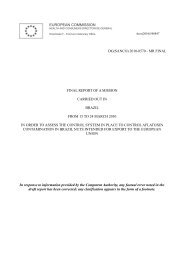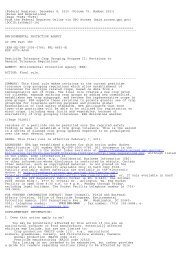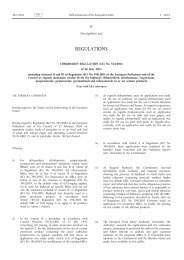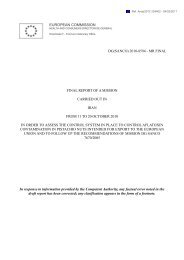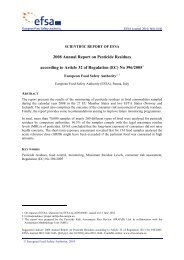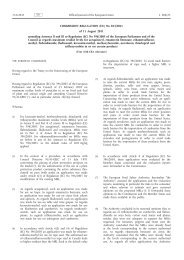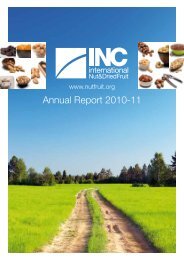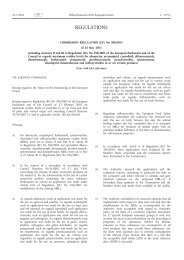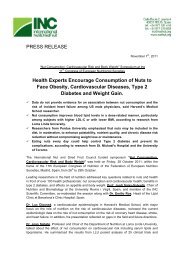2011 Codex Committee on Contaminants in Foods - Institute of Food ...
2011 Codex Committee on Contaminants in Foods - Institute of Food ...
2011 Codex Committee on Contaminants in Foods - Institute of Food ...
- No tags were found...
You also want an ePaper? Increase the reach of your titles
YUMPU automatically turns print PDFs into web optimized ePapers that Google loves.
REP11/CF Appendix II 45FERMENTATION18. Selected yeast preparati<strong>on</strong>s for the producti<strong>on</strong> <strong>of</strong> spirit dr<strong>in</strong>ks should be added to the mashed fruits,accord<strong>in</strong>g to the manufacture’s <strong>in</strong>structi<strong>on</strong>s for users, for a fast and “clean” fermentati<strong>on</strong>.19. Mashed fermented fruits should be handled with high standards <strong>of</strong> hygiene, and exposure to lightshould be m<strong>in</strong>imised. Fermented fruit mashes c<strong>on</strong>ta<strong>in</strong><strong>in</strong>g st<strong>on</strong>es should be stored as briefly as possible beforedistillati<strong>on</strong> s<strong>in</strong>ce hydrocyanic acid may also be released from <strong>in</strong>tact st<strong>on</strong>es dur<strong>in</strong>g prol<strong>on</strong>ged storage.20. If the mash is prepared by macerat<strong>in</strong>g st<strong>on</strong>e fruit <strong>in</strong>to alcoholic beverages or ethyl alcohol, the st<strong>on</strong>efruit should be removed so<strong>on</strong> after the aroma <strong>of</strong> the st<strong>on</strong>e fruit is adequately extracted.DISTILLATION EQUIPMENT21. Distillati<strong>on</strong> equipment and the distillati<strong>on</strong> process should be suitable, to ensure that hydrocyanic acidis not transferred <strong>in</strong>to the distillate(a)(b)(c)(d)Use <strong>of</strong> a copper still will limit carryover <strong>of</strong> ethyl carbamate–form<strong>in</strong>g precursors <strong>in</strong>to thedistillate.The distillati<strong>on</strong> equipment should preferably <strong>in</strong>clude automatic r<strong>in</strong>s<strong>in</strong>g devices and coppercatalytic c<strong>on</strong>verters. The automatic r<strong>in</strong>s<strong>in</strong>g devices will keep the copper stills cleaned while thecopper catalytic c<strong>on</strong>verters will b<strong>in</strong>d hydrocyanic acid before it passes <strong>in</strong>to the distillate.Automatic r<strong>in</strong>s<strong>in</strong>g devices are not necessary <strong>in</strong> the case <strong>of</strong> disc<strong>on</strong>t<strong>in</strong>uous distillati<strong>on</strong>. Thedistillati<strong>on</strong> equipment should be cleaned by systematic and thorough clean<strong>in</strong>g procedures.When copper catalytic c<strong>on</strong>verters or other dedicated cyanide separators are not available, copper(I) chloride preparati<strong>on</strong>s can be added to the fermented fruit mash before distillati<strong>on</strong>. Thepurpose <strong>of</strong> these preparati<strong>on</strong>s c<strong>on</strong>ta<strong>in</strong><strong>in</strong>g copper (I) i<strong>on</strong>s is to b<strong>in</strong>d hydrocyanic acid before itpasses <strong>in</strong>to the distillate. Copper (II) i<strong>on</strong>s are without effect and should not be used.22. While copper i<strong>on</strong>s can <strong>in</strong>hibit formati<strong>on</strong> <strong>of</strong> ethyl carbamate precursors <strong>in</strong> the mash and <strong>in</strong> the still, theycan promote formati<strong>on</strong> <strong>of</strong> ethyl carbamate <strong>in</strong> the distillate. Therefore, use <strong>of</strong> a sta<strong>in</strong>less steel c<strong>on</strong>denser at theend <strong>of</strong> the distillati<strong>on</strong> device rather than a copper c<strong>on</strong>denser will limit presence <strong>of</strong> copper <strong>in</strong> the distillate andreduce the rate <strong>of</strong> ethyl carbamate formati<strong>on</strong>.DISTILLATION PROCESS23. St<strong>on</strong>es settled <strong>in</strong> the fermented mash should not be pumped <strong>in</strong>to the distillati<strong>on</strong> device.24. Distillati<strong>on</strong> should be carried out <strong>in</strong> such a way that alcohol is boiled <strong>of</strong>f slowly and <strong>in</strong> a c<strong>on</strong>trolledmanner (e.g. by us<strong>in</strong>g steam <strong>in</strong>stead <strong>of</strong> a direct flame as the heat<strong>in</strong>g source).25. The first fracti<strong>on</strong>s <strong>of</strong> the distillate, called ‘heads’, should be separated carefully.26. The middle fracti<strong>on</strong>, called ‘hearts’, should then be collected and should be stored <strong>in</strong> the dark. Whenthe alcohol c<strong>on</strong>tent <strong>of</strong> the actual distillate reaches 50 % vol. at the receiver, collecti<strong>on</strong> should be switched tothe ‘tails’, so that any ethyl carbamate that may have been formed is separated <strong>in</strong> the tail fracti<strong>on</strong>.27. Some manufacturers may redistill the separated tails, possibly c<strong>on</strong>ta<strong>in</strong><strong>in</strong>g ethyl carbamate. If the tailsare used for re-distill<strong>in</strong>g, they should be re-distilled separately, however for reducti<strong>on</strong> <strong>of</strong> ethyl carbamatec<strong>on</strong>centrati<strong>on</strong> it is preferable to discard the tail.CHECKS ON THE DISTILLATE, RE-DISTILLATION AND STORAGEHydrocyanic acid28. Test<strong>in</strong>g for hydrocyanic acid may be used as a simple test for ethyl carbamate <strong>in</strong> distillates. Therefore,the distillates should be regularly checked for their levels <strong>of</strong> hydrocyanic acid. The determ<strong>in</strong>ati<strong>on</strong> could becarried out by specific tests <strong>in</strong>clud<strong>in</strong>g kits for rapid test<strong>in</strong>g <strong>of</strong> the hydrocyanic acid levels.29. If the c<strong>on</strong>centrati<strong>on</strong> <strong>of</strong> hydrocyanic acid <strong>in</strong> the distillate exceeds a level <strong>of</strong> 1 mg/l, re-distillati<strong>on</strong> withcatalytic c<strong>on</strong>verters or copper preparati<strong>on</strong>s is recommended.30. Distillates should be stored <strong>in</strong> bottles that are lightpro<strong>of</strong> (or filter ultraviolet light) or <strong>in</strong> cover<strong>in</strong>g boxesand not at higher temperatures.



